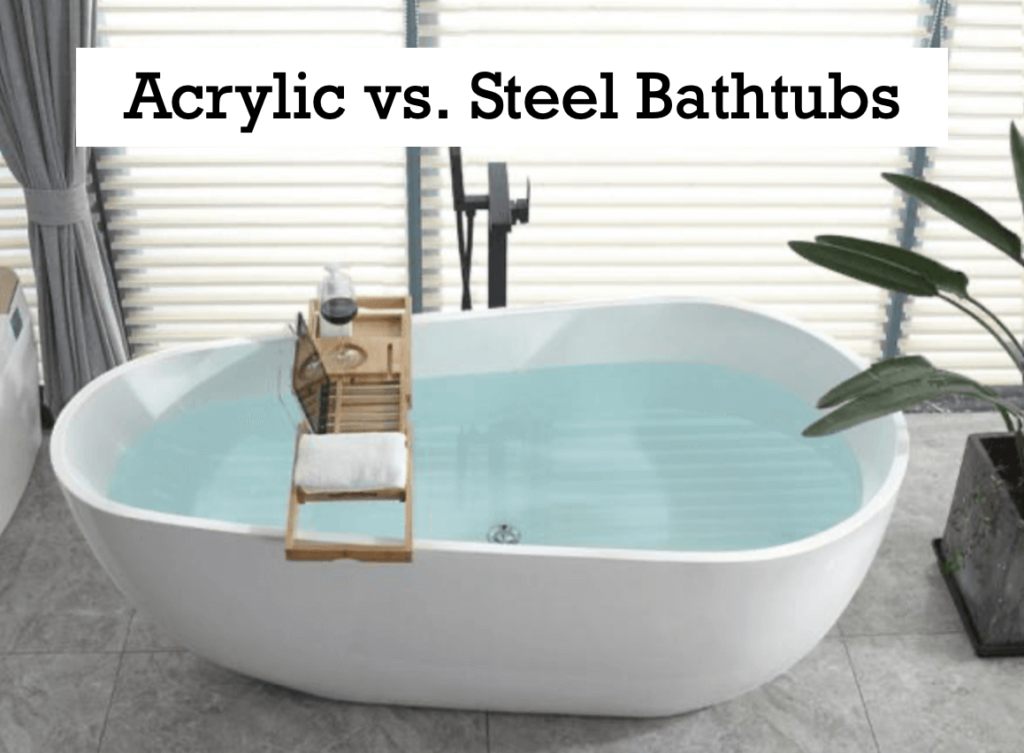Mississippi Landsource wants You to know acrylic vs steel bathtubs whenever you are looking for a bathtub, it is essential to consider the primary material used to manufacture it. There are various materials used for bathtubs, but you will surely come across two popular materials: acrylic and steel. Since both have their own advantages and disadvantages, it is very important to know the difference between them so you can determine which bathtub would be better for your specific needs.
Here’s the complete comparison between the acrylic bathtub and steel bathtub to guide you in choosing which type is best for your needs.

Manufacturing Method
Acrylic and steel tubs are made very differently, from the raw materials to the actual construction process, so the manufacturing method is a key factor when making your selection.
Acrylic tubs are made of sheets of plastic that are reinforced with fiberglass, which gives them a lightweight yet durable construction. They are tougher and more flexible than steel tubs, which makes them available in a variety of shapes, styles, and designs. Steel tubs, on the other hand, are made from a single sheet of steel that is pressed into a mold, sprayed with an enamel coating, and then furnace-treated to help create a strong, durable, non-porous surface. The majority of the time acrylic tubs are lighter in weight than steel ones, but steel models tend to last longer.
Heat Retention
After a long day, there’s nothing more relaxing than soaking in a hot tub. Thus, you can’t compare acrylic vs. steel tubs without looking at heat retention.
Acrylic bathtubs do fairly well at retaining heat, so you don’t have to continuously refill the tub to keep the water warm. It heats the water quickly to a consistent temperature, and because it’s lined on the inside, it insulates the heat, reducing your water heating costs each month.
Steel tubs, however, work as a conductor, allowing heat to evaporate thereby cooling the water faster. While the tub itself heats up quickly when hot water is added, it also loses that heat relatively quickly.
Corrosion
In the steel bath vs. acrylic bath debate, steel baths take a huge hit when it comes to corrosion. Acrylic doesn’t corrode and it doesn’t collect germs or build up bacteria to damage the surface of the tub, which means you don’t have to worry about making sure the tub is clean constantly.
While steel tubs also don’t allow damage from bacteria and mold, it is possible that rust will appear after a certain period of time, especially in areas where there is water leakage or chipping of the enamel coating.
Scratch Resistance
Since steel tubs are reinforced with a hard-wearing enamel, they are highly resistant to scratches and acid detergents—more so than acrylic tubs. Damage to steel tubs is harder to repair than in the case of acrylic tubs. While acrylic tubs may incur scratches more easily, these surface scratches can often be fixed with ease and cost less than the steel to repair.
Maintenance
Bathrooms are used a lot during the day, and with constant use comes maintenance. While both acrylic and steel tubs are fairly easy to maintain, acrylic bathtubs can be more reliable and are not as hard to maintain as steel.
Durability
The durability of an acrylic bathtub is undeniable when compared to many similarly priced materials like fiberglass, but they don’t come close to metals like steel or cast iron. Both acrylic and steel tubs are a good choice if you’re looking for a tub that will last a while, though a steel tub will likely last a lot longer.
Weight
With an average weight of 30 pounds, the acrylic tub is one of the most lightweight materials on the market, making these tubs very easy to maneuver and install making it the obvious choice for renovating existing bathrooms. Steel tubs, however, are usually over 300 pounds—some weigh as much as 500. This makes installation more labor-intensive and time-consuming. Installing a steel tub on the upper levels of the home is especially tricky and requires reinforcements to ensure safety.
Cost
Comparing steel vs. acrylic baths in terms of price can be difficult since the cost difference largely depends on the specific model you want. But the majority of the time, since an acrylic bath is lighter, it often costs less than a comparable steel model, which can be heavier and more expensive to manufacture. While they have price differences, both are relatively inexpensive options compared to tub materials like cast iron, marble, and stone.
Steel vs. Acrylic Bath: Which One is For You?
The bathtub is one of the most important fixtures in your bathroom. Whether you’re soaking at the end of a long day, taking a shower before work, or reading in your tub with a glass of wine, the comfort and style of the tub you choose can have an impact on quality of life—and your home’s resale value.
If you’re looking to upgrade your bathtub and are confused about which one between steel and acrylic is best for you, we recommend consulting an expert to find out which tub is right for you. Call 844-308-9135 or visit us online today to get a quote or schedule a free, in-home consultation so we can help you identify which one will suit your needs!
If you have home improvement questions call Mississippi Landsource today at 601-966-4657. And if you didn’t find what you needed today check out our sister site Texas Landsource for more information.
